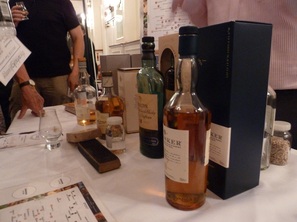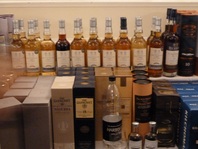While entering the event and seeing a room full of whisky (not literally, I imagine that would make for a painful swim) was exciting, it also made me realise how few of the names I actually recognised.
So I had my little list of whiskies I loved (Jura; Talisker; Laphroaig) and ones I wasn’t so keen on (Peat Monster; anything that costs less then a tenner from a corner shop). What now?
It seemed like the best place to start would be to approach one of the stalls confidently, disguise my utter lack of knowledge, and trick them into telling me everything I would need to know. The nearest stand had a wide range of bottles on, including Japanese makes and others I didn’t recognise.
“What can you tell me about this?” I asked, waving my hand over some bottles, “I assume from the name it’s some kind of German whisky? Interesting, I didn’t know the Germans produce whisky.”
It wasn’t a German whisky called Auto-something, as I had misread and assumed. It was Auchentoshan (Ock-en toh-shan), a single malt scotch, as was quickly pointed out to me. But the man running the stall didn’t bat an eyelid, he just introduced the drinks, told us a bit about them and poured some out for us to try, talking us through the flavours.
The program I got on the way in to the festival warns “do not be insulted by the small measures poured into your glass”, which made me worry there might be some stinginess at play, as all drinks are included in the ticket price, but I was wrong. I talked to one professional taster who was tasting every whisky and tipping any excess into the buckets of sawdust provided. I couldn’t bring myself to do that, but with so much on offer it turned out that the measures began to feel extremely generous.

The stall run by Diageo Scotland featured one of the most useful things I picked up all day: the whisky flavour map.
Apparently this was put together by “independent whisky expert” David Broom, and according to the incredibly helpful man on the stall, represents a newer way of thinking about whisky: “people traditionally thought of whisky like wine, meaning that there was a lot of emphasis on things like where the barley was grown, and the location of the distillery. But these days that’s balls. It’s an industrial process, very few distilleries are by the place where the barley is grown and the casks might come from somewhere else again. What’s important is the process, so we developed this to explain the different flavour profiles of whisky and help people understand what they’re drinking.”
Now I should point out that the view that you can totally divorce the finished product from where it was made wasn’t shared by everyone there. Some of the smaller distilleries, especially, do everything on one site and talk about the local qualities of their raw materials. But in terms of understanding the tastes and types of whisky, I couldn’t point you towards a better starting point than that map.

The friendliness of the different stall holders gave me the courage to begin asking some more basic questions. Such as, “hang on, what exactly is whisky made of?”
It turns out that is a very simple question to answer: barley, yeast and water are all that go into malt whisky. The production of grain whisky can also use corn, while a blended scotch is made from a blend of the two types.
The smokiness or peatyness which is a feature of so many whiskies isn’t created by the addition of another ingredient, but by smoking the barley. Dried barley is laid out on sheets, and peat is smoked underneath them. The longer the smoking process, the stronger the flavour. Some of the stalls had samples of both plain and smoked barley available for people to smell – with the latter much sweeter and smokier.
After the spirit has been distilled from the barley, the result is a clear spirit with a harsh, sharp smell (likened by more than one stall holder to vodka. Vodka seems to be practically a swearword within the whisky business). What turns this spirit into whisky is being aged in oak casks – for a minimum of three years before it can legally be called whisky. The spirit picks up colour and flavour from the wood, and if it has been charred or used to hold other drinks, this will affect the flavour.
Single cask whisky is the result of one cask, but most production process will include vatting batches from several different casks together. Producers also move whiskies into other barrels to produce different flavours and colours. Most barrels have previously held beer, but ones that held bourbon and sherry are often used as well.
Each cask is used an average of six times. One man I spoke to likened this to reusing a teabag - the first few cups are all strong, and then they get weaker. The cheap whisky you see was probably made on one of the barrels final uses – and will probably include caramel as a colouring to make it look the way we expect, as there is nothing left to pick up from the wood.
I didn’t realise that, unlike wine, whisky does not age once it’s bottled. So if you find one you particularly like it will be as good in a few year’s time as it is today!
What really brought home to me how long-winded the whisky process is was speaking to somebody from the English Whisky Company, who are based in Norfolk. It is the first distillery south of Hadrian’s Wall in over 100 years, and they have only just produced their first five-year whisky. I tried some and while it was alright, it didn’t really do it for me. But looking at the competition – many with bottles that had been aged for 10 years or longer – I realised that this is a business where producing your first batch takes longer than some pop stars’ careers. So I’ll be going back and trying more as they mature.

I still consider myself a beginner when it comes to whisky – but now I understand what’s out there, and I can’t wait to explore it. My pick of the festival? A 1979 Bunnahabhain – dark and sweet and one I will probably never get the chance to try again.
Louise attended the Brighton 2011 Whisky Festival, which was run by the whisky lounge as part of Brighton Food Festival.
 RSS Feed
RSS Feed
